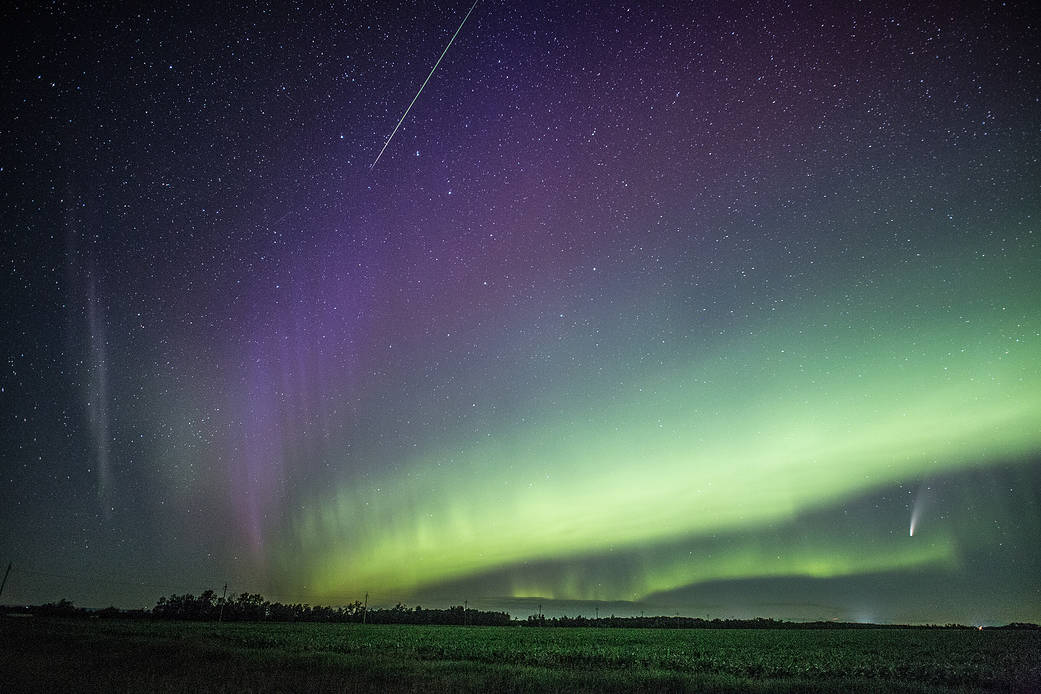Comets, Centaurs, and Trans-Neptunian Objects
Exploring the Echoes of Formation in the Outer Solar System
Walter Harris
Chief Scientist, University of Arizona Space Institute
University of Arizona
Sponsored by PSW Science Members Erica & Bruce Kane
About the Lecture

Comets are volatile rich remnants of the tumultuous planet-building epoch of solar system formation. They are small (of order 1-100 km in diameter) porous bodies with minimal cohesion that were among the first objects of any significance to form within the disk of material orbiting the proto-Sun. While the Sun was evolving toward the main sequence, comets became aggregated into protoplanetary bodies of increasing size, ultimately coalescing into the cores of the giant planets. The vast majority were lost to this planet formation process or were ejected as the young solar system organized itself into its modern configuration. The physical properties and the orbits occupied by the tiny fraction of comets that remain are our clearest view back to the origin and evolution of the outer solar system.
Research on comets has historically focused on the small subset that have been perturbed from their remote reservoirs into the inner solar system, where they are warmed by the Sun and gradually dissipate into clouds of gas and dust. Research has used remote sensing of this escaping material to search for insights into the composition of comet nuclei and, based on this information, the properties of the protoplanetary disk. This is an imperfect perspective because the process of heating and liberating the outer layers of a comet alters their primordial characteristics and ultraviolet light from the Sun breaks down their molecular compounds as they expand outward into space. The few comets that have been visited with spacecraft show dramatic evidence of physical evolution over multiple solar passages as the surface is eroded away. Studies of less altered bodies would clearly add much to our understanding of primordial comet composition. Unfortunately, the closest comet reservoir is beyond the orbit of Neptune.
This presentation will summarize some highlights of our understanding of the properties and orbital distribution of comet nuclei and what they tell us the early solar system. It will also describe some of the major questions that remain and how future exploration of a sub-group of comets called Centaurs may help us to answer them. Lastly, it will review some of the most compelling potential targets for Centaur study and discuss prospects for visiting them in the near future.
Selected Reading & Media References
https://www.esa.int/Science_Exploration/Space_Science/Rosetta_overview
https://solarsystem.nasa.gov/solar-system/kuiper-belt/arrokoth-2014-mu69/in-depth/
http://www.solarsystemcentral.com/comets_page.html
In a first, astronomers spotted a space rock turning into a comet
https://news.arizona.edu/story/beyond-jupiter-researchers-discovered-cradle-comets
https://meetingorganizer.copernicus.org/EPSC-DPS2019/EPSC-DPS2019-1094-1.pdf
https://meetingorganizer.copernicus.org/EPSC-DPS2019/EPSC-DPS2019-2025.pdf
About the Speaker

Walt Harris is Professor of Planetary Science at the University of Arizona, Chief Scientist of the Arizona Space Institute, and Deputy Director for Community Engagement at the Space4 Center.
Walt’s research is focused on the structure of thin atmospheres and their transition to and interactions with the space environment. He is particularly interested in the information that comet atmospheres provide about basic photochemical processes, the formation of the solar system, and the characteristics of the solar wind. He is also engaged in an ongoing study of the plasma interface between the solar wind and interstellar medium via remote sensing of interstellar neutral material as it passes through the solar system.
In addition to his research program, Walt has over 30 years of experience in the development and use of spectroscopic instrumentation, with an emphasis on suborbital flight. His research group is currently engaged in an instrument development effort in the area of spatial heterodyne spectroscopy (SHS). SHS instruments occupy a special observational niche by providing very high velocity resolution of angularly extended emission line targets with much higher sensitivity than classical spectroscopy. Current funding for SHS development has led to new instruments for both ground (visible band) and suborbital (far ultraviolet) observations of comets and the interplanetary medium.
Walt earned a BS in Astronomy and a BSEng in Engineering Physics at the University of Illinois, Champaign-Urbana and a PhD in Astronomy and Atmospheric and Space Science at the University of Michigan, Ann Arbor.
Minutes
On March 17th, 2023, from the Powell Auditorium of the Cosmos Club in Washington, D.C, and by Zoom webinar broadcast on the PSW Science YouTube channel, President Larry Millstein called the 2,474th meeting of the Society to order at 8:02 p.m. ET. He welcomed new members, and the recording secretary read the minutes of the previous meeting.
President Millstein then introduced the speaker for the evening, Walter Harris, Chief Scientist at the University of Arizona Space Institute. His lecture was titled, “Comets, Centaurs, and Trans-Neptunian Objects.”
Harris began the lecture by exploring the echoes of formation in the outer solar system. He discussed his research on the structure of thin atmospheres, their transition to and interactions with the space environment, and the formation of the solar system.
Harris provided an outline for his lecture, beginning with the formation of planetary systems, then he would discuss the late stages of forming the planetary system and the role comets played in the process, and the nuclei of comets, which are different from the ball of gas and tails visible from Earth.
Harris delved into the limitations of observing comets explained how comets are formed. One way comets are formed is through a process called accretion, which is where small particles, such as dust and gas, accumulate over time to form larger objects. Another way comets are formed, Harris explained, is through a process called gravitational collapse, which occurs in areas of higher density in a disk of gas and dust. In these areas, there is enough gravity to cause the gas and dust to collapse in on itself, forming small objects that can eventually grow into comets.
The speaker mentioned that Uranus and Neptune appear to be planets made entirely of comets and that there is a planet 300 times the mass of Earth and several others in the outer solar system that have large gravitational imprints on small comets.
The speaker went on to explain the characteristics of different types of comets by plotting their orbital inclination, eccentricity, and apelion distance. He pointed out that comets with very large separations from the Sun have no particular inclination and are isotropic. Those in close proximity to the Sun have reasonable small orbits of 20-100 years and are mostly close to the ecliptic.
Harris then explained that objects with spherical incoming distribution have very long periods and come from very far away, almost halfway to the nearest star. Short-period comets with orbital periods of 20 years or less are called Jupiter family comets, whose orbits are phased with Jupiter. Long-period comets with orbital periods of more than 200 years are rarely seen more than once.
Harris then discussed the composition and identification of comets and their properties. He mentions that comets are typically weak and have no cohesion, which causes them to break apart easily. He gives examples such as Comet Shoemaker Levy 9, which broke apart when it had a close approach to Jupiter. He also talks about Comet 1995 Schwassmann Walkman which broke apart but did not dissipate and continues to orbit the sun as individual fragments. The speaker suggests that comets are rubble piles consisting of individual comets put together.
Harris then discussed spacecraft missions to visit comet nuclei and mentions that six have been visited so far.
Next the question and answer period began.
One member asked what is a non-gravitational force in relation to comets, and how does it make it difficult to predict their orbit? Harris responded that when comets lose mass, they behave like a rocket and constantly change their position, making it difficult to predict their orbit. This phenomenon is called a non-gravitational force.
Another member asked why Shoemaker Levy 9 form a long train of objects when it fragmented, while other comets, like Hartley 2, fragmented into little pieces that stayed together? Harris responded by explaining that the long train of objects is the direction in which everything was going, and it has to do with the extent of the tidal forces that were pulling it apart and how much residual velocity was there. However, comets like Hartley 2 are very close to the Sun and quite active, so there are a lot more non-gravitational forces which split the objects out into different areas, but they are all still very close to the original orbit.
After the question and answer period, President Millstein thanked the speaker, made the usual housekeeping announcements, and invited guests to join the Society. President Millstein adjourned the meeting at 9:51 p.m.
Temperature in Washington, D.C.: 14° C
Weather: Cloudy
Attendance: 59 and the number of online viewers in the first two weeks of posting was, 472.
Respectfully submitted,
Cameo Lance, Recording Secretary